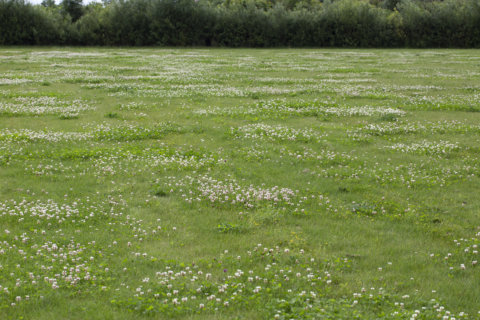
Clover used to be required in grass seed mixes because it helps to feed the lawn. Then the chemical companies convinced us it was a weed.
Are you concerned about our native bees? Perhaps you’ve created flower beds that attract pollinators, and you are feeling good about your efforts. Don’t stop there!
Grow a Bee Friendly Lawn too. Your lawn is a great place to help pollinators. A lawn that contains only grass is a dead zone for bees and other beneficial insects. It’s time to take another look at plants that we define as weeds.
According to the Xerces Society, a “lush, green, weed-free lawn is as American as apple pie. It tells the whole neighborhood that you are a competent, hard-working, contributing member of society. Dandelions and an overgrown lawn are a sign of neglect, incompetence, and laziness—or so our culture would have you believe.”
We don’t believe it. We agree with the Xerces Society that it’s time to rethink your lawn care. Allowing some some flowering plants to grow in your lawn will help our bees and butterflies. And changing the way we maintain our lawns can help create a healthier planet.
Join the movement to grow a Bee Friendly Lawn. If people here and across the country adopted more environmentally friendly lawn care practices, it could potentially have a big impact. Americans maintain roughly 40 to 50 million acres of lawn, making turf grass the single largest irrigated crop we grow. NASA estimates that the U.S. grows more than three times as much grass lawn as irrigated corn.
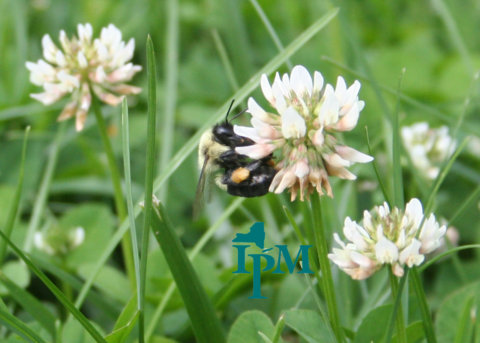
Carpenter bee on white clover. NY State IPM Program at Cornell University.
Benefits of clover
Many bees and other helpful insects feed on clover. It is a great source of nectar. Bees love all varieties of clover.
And clover acts as a natural fertilizer. “Clover converts nitrogen from the air into ammonium,” according to mygreenmontgomery.org. Grass absorbs the ammonium, making it greener and stronger.
Clover is resilient. It stays green all summer, with little or no watering. And its strength actually smothers other weeds.
Clover used to be a standard component of all lawn seed mixes. ![]() “Gardeners knew the benefits of having multiple species present in a lawn and having clover as one of those species,” according to Yardthyme.
“Gardeners knew the benefits of having multiple species present in a lawn and having clover as one of those species,” according to Yardthyme.
After World War II however, things changed. Chemical companies had been making chemical weapons for the war. Post-war, they switched their focus to making herbicides and pesticides. To sell the products, they created marketing campaigns.
One campaign set out to convince lawn owners that the perfect lawn consisted of just grass. Clover was suddenly defined as a weed that needed to be eradicated.
“There was no ecological or practical need for eliminating clover from the standard backyard,” said Yardthyme. “it was purely driven by a marketing campaign that wanted people to spend money on pesticides.” People could now buy lawn herbicides that killed everything but grass.
And the companies could then sell them fertilizers to make up for the free nitrogen the clover had provided but that was no longer present in the lawn. “For organic lawn care providers, clover in the turfgrass has been a free tool for healthy lawns,” said mygreenmontgomery.org.
While most clover species will thrive in a lawn, Dutch white clover (Trifolium repens) is most available. This clover has larger leaves and taller plants. It can sometimes be aggressive if your lawn grasses are not dense. Another option is a smaller, lower growing clover that can be easily mowed and blends in more with the grass. Look for Trifolium repens ‘Pipolina’, or micro-clover.
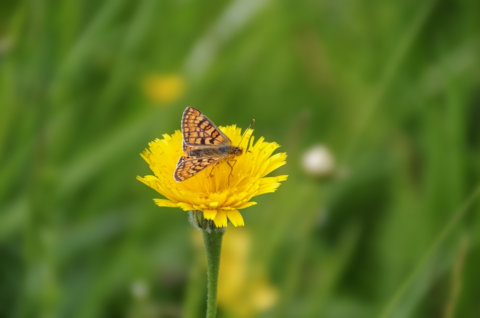
Dandelions are important food for bees and butterfly larvae, especially early in the season.
Benefits of dandelions
Mason bees, other bees and butterflies all feed on dandelions. According to AP News, dandelions play a crucial role in the health of bees and butterfly larvae in April and May. For this reason, John Molseed advised in his AP News column to let dandelions grow for the first part of the season rather than immediately mowing them down.
“The flowers are an important food source for pollinators — especially bees,” he noted. Dandelions provide both pollen and nectar. By late May, more flowering plants are available as food sources for bees and other insects, so dandelions become less important for their diet.
So let some dandelions grow in your lawn to help beneficial insects. And if you decide later that your lawn has too many dandelions, you can easily remove some of them with a hori hori knife. Do you really need to use weed killers and harm the bees?
Plant flowers to attract bees in your lawn
Some people purposely plant flowering plants in their lawn to attract bees and other pollinators. We talked about clover above. Two other options are self-heal (Prunella vulgaris) and creeping thyme (Thymus sepryllum). Some people grow English daisies as part of their lawn. Others replace the lawn with wildflower mixes adapted for the Pacific Northwest.
Native violets (Viola spp.) may already be present in your lawn. It’s a good idea to encourage violets as they are valuable host plants for fritillary butterflies.
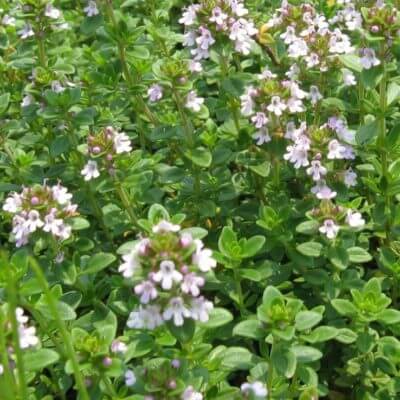
Creeping thyme.
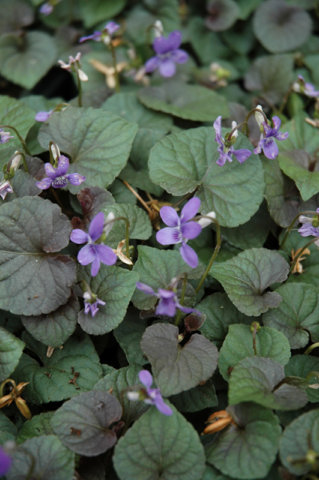
Native violets.
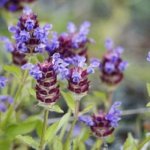
Self-heal.
If you decide to take the approach of adding flowers to your lawn, it may begin to look more like a meadow over time: that is, less manicured and tidy. In this case, we suggest keeping a mowed buffer and letting the rest of the lawn grow more naturally. If the edge looks tidy, the rest of the space looks intentional rather than neglected.
In Harmony’s approach to Bee Friendly Lawn care
In Harmony works in partnership with our clients to keep lawns healthy. If you are a natural lawn care client, we regularly monitor your lawn and soil health. We feed the lawn with slow-release organic fertilizers several times over the growing season. We may also use other treatments, such as lime and corn gluten, as needed. We also offer fall or spring aeration and overseeding.
We encourage our clients to help the bees by growing a lawn that includes some flowering plants, such as clover and dandelions, rather than eradicating them all. We ask our clients to follow our mowing guidelines and watering guidelines throughout the year so the lawn stays healthy.
We will not use weed and moss killer on lawns that are not maintained properly. Integrated Pest Management guidelines say that pesticides should not be used without proper watering and mowing practices.
Here are the rest of our tips on how to grow a Bee Friendly Lawn. #BeeFriendlyLawn.

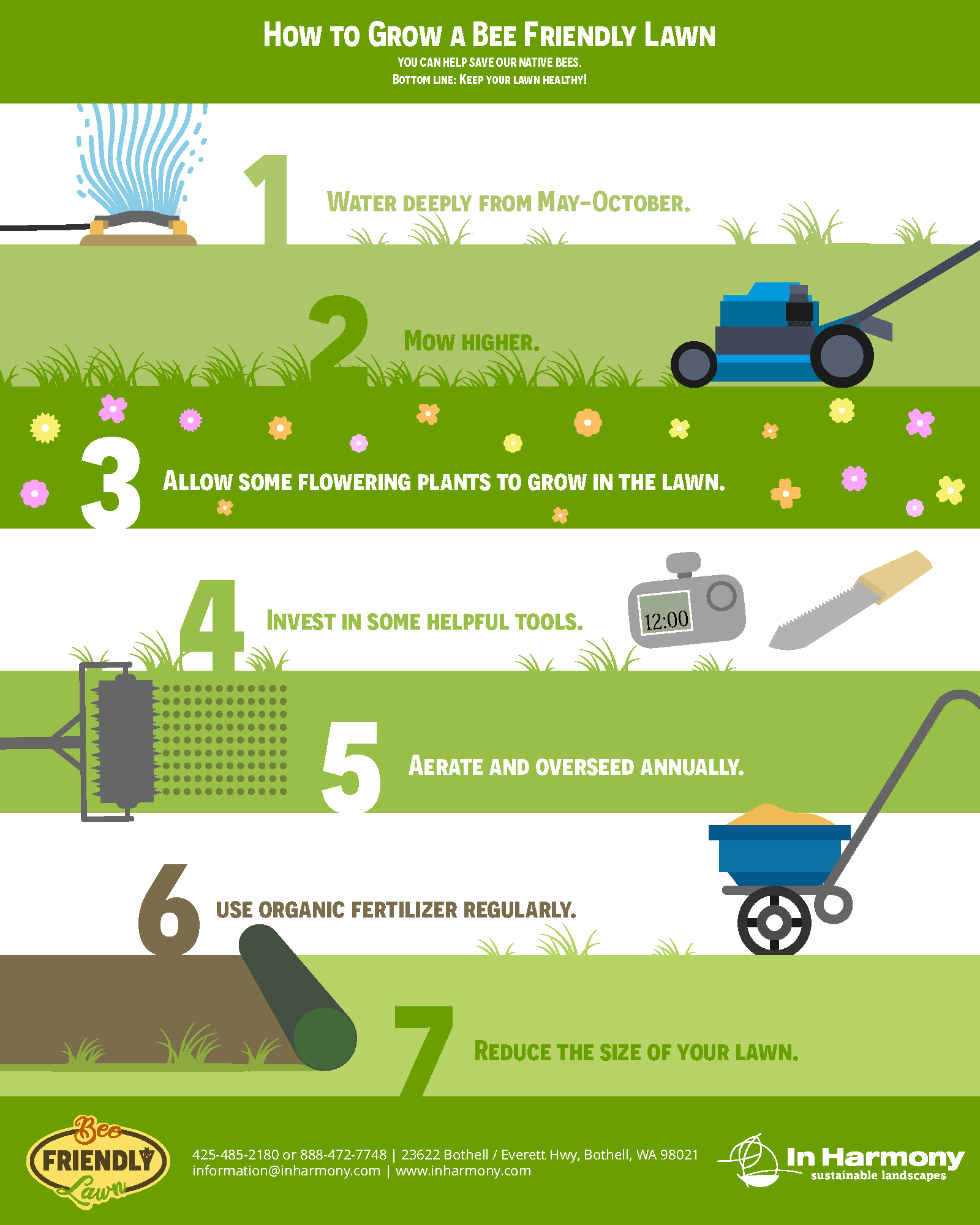
I work in a school and we have a native bee hive within the school grounds. If we were to try to grow the bee friendly lawn would we start with a small area? My thoughts would be to partition a section off and begin the process. I would be grateful in any help you might be able to offer. We are in Bundaberg Qld, Australia. Thank you
I work in a school and we have a native bee hive on the grounds. We would like to make a bee friendly lawn and I am wondering how we would go about it? I am thinking of doing a small area first.
Hello Karen,
Thanks for your interest in having a bee friendly lawn. Check out this page on our website for tips on growing a bee friendly lawn. And let us know if you have questions.
https://inharmony.com/sustainable-landscapes/sustainable-landscape-approaches/bee-friendly-lawn/